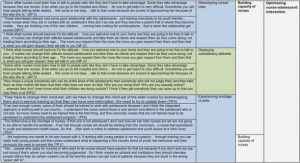Get Complete Project Material File(s) Now! »
RESEARCH PARADIGM FOR THIS STUDY
In reaction to the modernist research paradigm which focuses on impartial and objective reason, I approached the study with a post-modernist view, placing a high premium on human perception and experience (Spies, 2006, p. 32). The modernist research paradigm is similar to a positivist worldview which presupposes a single objective reality that can be observed, recognised and measured. In contrast, post-positivist thought or a post-modernist worldview presupposes multiple, subjective realities that are a function of personal interaction and perception (Merriam, 1988, p. 17).
The interpretive paradigm within a qualitative research design involving field settings offers a means of investigating complex social units consisting of multiple variables of potential importance in understanding the phenomenon.
Anchored in real-life situations, this type of study results in a richly descriptive and holistic account of the phenomenon. It offers insights and illuminates meanings that expand the reader’s experiences. These insights can be construed as tentative hypotheses that help structure future research; hence they play an important role in advancing a field’s knowledge base (Merriam, 1988, p. 32). Because of its strengths, the interpretive aspect of qualitative research was particularly appealing to me, applying it in a field of study such as arts education.
Qualitative research, however, also has certain limitations and weaknesses, as identified by Merriam (1988). The first limitation lies in the fact that time and financial constraints sometimes preclude the researcher from conducting an exhaustive study. Secondly, this type of study may lead readers to the erroneous conclusion that that which applies to certain cases also applies automatically to the class from which they are drawn. Thirdly, qualitative research employs the researcher as the primary data collection instrument, thus implying limitations in terms of sensitivity and integrity. Therefore, all effort has been made by me as researcher to be as objective and unbiased as possible, gaining insights from a variety of role players in the field being studied.
The overall objective of this study was to deepen the understanding of the dynamics between the curriculum (RNCS), how it is interpreted by individual teachers, and how it is translated into action in real classrooms. It furthermore aimed to explore how lecturers and teachers in the learning area Arts and
Culture understand, interpret and act on the curriculum policy.
Two main approaches were used for the collection of data: interviews, and document and resource material analysis.
This research included a relatively small number of teachers (63). The purpose was not to discover how many people share certain experiences, but rather to gain access to the experiences and perceptions of some teachers implementing music in the Arts and Culture learning area. Looking at a much larger sample of teachers would not have added any more value to the research, and it would have failed to notice the depth that was afforded by working with a smaller group of teachers. The procedure of one-on-one interviews at various schools was adopted in order to provide in-depth data as well as multiple viewpoints. Sites were determined by the sampling strategy.
Purposive sampling
The sampling strategy was mostly purposive, since knowledge and expertise about the research problem were used to identify respondents who represent the criteria needed for the investigation (Berg, 2004, p. 36; Cohen et al., 2002, p. 143). A measure of snowball-sampling was also implemented by asking the first interviewees to recommend other teachers and references in the field (Cohen et al., 2002, p. 144). Lecturers at universities and First Education Specialists (FESs) were also consulted regarding schools where a high standard of Arts and Culture programmes were being presented.
For this study, purposive samples were selected after initial field investigations, to ensure that certain types of individuals were included who display specific types of attributes. There were three categories of respondents:
• firstly, teachers currently involved in teaching Arts and Culture in schools;
• secondly, lecturers involved in training programmes in Arts Education; and
• thirdly, policy makers involved in the planning and execution of the learning area Arts and Culture.
CHAPTER 1: INTRODUCTION
1.1 PURPOSE AND RATIONALE OF THE STUDY
1.2 RESEARCH QUESTIONS
1.3 RESEARCH DESIGN AND METHODOLOGY
1.4 DELIMITATIONS OF THE STUDY
1.5 PROBLEMS ENCOUNTERED DURING THE STUDY
1.6 OUTLINE AND ORGANISATION OF THE THESIS
1.7 VALUE OF THE STUDY
1.8 NOTES TO THE READER
CHAPTER 2: LITERATURE REVIEW
2.1 INTRODUCTION
2.2 THE ARTS
2.3 CULTURE
2.4 INTEGRATION OF THE ARTS
2.5 MUSIC AS COMPONENT OF AN ARTS EDUCATION
2.6 CONCLUDING REMARKS
CHAPTER 3: RESEARCH DESIGN AND METHOD
3.1 INTRODUCTION
3.2 RESEARCH DESIGN AND METHODOLOGY
3.3 RESEARCH PARADIGM FOR THIS STUDY
3.4 SAMPLING STRATEGY
3.5 DATA COLLECTION STRATEGIES
3.6 INTERVIEWS
3.7 QUESTIONNAIRES
3.8 DATA ANALYSIS
3.9 ETHICAL CONSIDERATIONS
3.10 VALIDITY AND RELIABILITY
CHAPTER 4: COLLECTION AND ANALYSIS OF DATA
4.1 INTRODUCTION
4.2 METHOD OF ANALYSIS
4.3 ANALYSIS OF INTERVIEWS
4.4 REVIEW OF ARTS AND CULTURE RESOURCES
4.5 SUMMARY
CHAPTER 5: OBE, THE RNCS AND A WHOLE-BRAIN APPROACH TO STUDENT TRAINING IN MUSIC EDUCATION
5.1 INTRODUCTION
5.2 OUTCOMES BASED EDUCATION
5.3 THE REVISED NATIONAL CURRICULUM STATEMENT
5.4 ACTIVE MUSIC MAKING AND SKILLS DEVELOPMENT IN MUSIC EDUCATION
5.5 MUSIC CONCEPTS IN THE RNCS
5.6 WHOLE-BRAIN LEARNING
5.7 TRAINING STUDENTS IN MUSIC EDUCATION
5.8 SUMMARY
CHAPTER 6: FINDINGS AND RECOMMENDATIONS
6.1 INTRODUCTION
6.2 FINDINGS OF THE RESEARCH
6.3 ANSWERING THE RESEARCH QUESTIONS
6.4 SUGGESTIONS FOR FURTHER RESEARCH
6.5 CONCLUSION
APPENDICES
SOURCES




